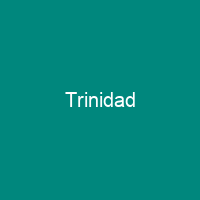Trinidad is the larger and more populous of the two major islands of Trinidad and Tobago. El Cerro del Aripo, at 940 metres, is the highest point in Trinidad. There are about 100 species of mammals including the Guyanese red howler, the collared peccary, the brocket deer, and the ocelot.
About Trinidad in brief

16% other mixed. Catholicism constitutes the largest religious denomination of the country. The variety of denominations has followed this pattern for decades: Protestant 32. 1%, Roman Catholic 21. 6%, Hindu 18. 2%, Muslim 5%, Jehovah’s Witness 1. 5%, other 8. 4%, none 2%, unspecified 11. 1%. There are about 100 species of mammals including the Guyanese red howler, the collared peccary, the brocket deer, and the ocelot. The fauna is overwhelmingly of South American origin including about 70 species of bats and about 400 species of birds including the Trinidad piping-guan. Trinidad’s eastern beaches are the largest nesting site in the western hemisphere for the leatherback turtle.
You want to know more about Trinidad?
This page is based on the article Trinidad published in Wikipedia (as of Dec. 04, 2020) and was automatically summarized using artificial intelligence.







